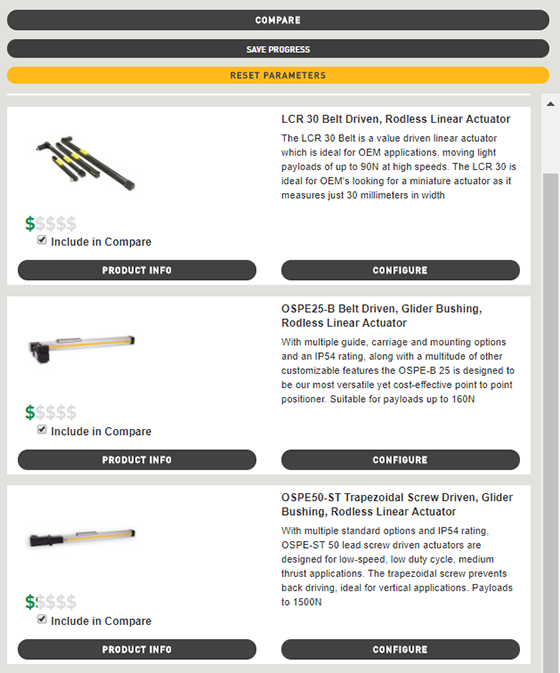Machine design challenges
 Pressures to reduce overhead cost and maximize profitability have forced original equipment manufacturers and machine builders to significantly reduce their engineering spend. With a multitude of options and technologies along with complex sizing and selection process, machine design has become a burdensome process. Design engineers must select the optimal automation components amid countless complicated calculations and selection tools.
Pressures to reduce overhead cost and maximize profitability have forced original equipment manufacturers and machine builders to significantly reduce their engineering spend. With a multitude of options and technologies along with complex sizing and selection process, machine design has become a burdensome process. Design engineers must select the optimal automation components amid countless complicated calculations and selection tools.
Specifying electromechanical componentry is more complex than selecting a catalog part number. System dynamics and other key considerations make engineers weary of selection from a simple attribute table. Performing the calculations required to properly size a motion system can often be a daunting and time-consuming task. Sales engineers and factory support are frequently consulted, and this often adds days to the process. Phone calls, emails and other touch points can significantly delay receiving a part number and CAD drawing.
The current state of sizing electromechanical components
In an environment focused on reducing engineering complexity and speeding time to design, how does one solve the challenge of sizing? Numerous sizing options exist for the implementation of electromechanical technology. Catalogs are often the starting point but do not provide confidence in your selection. Some electromechanical actuator suppliers use part configuration tools, but this does not solve the actuator sizing challenge. Some companies have created elaborate tools that function like sizing and selection software wizards walking you through a series of inputs. Application details are entered and eventually lead to a resultant product recommendation.
 Sizing with ease
Sizing with ease
Parker’s Virtual Engineer is one such tool and can help you streamline the sizing and selection process. Users navigate through a series of inputs covering a variety of application details that are critical to the actuator sizing process. Information like orientation, loading, condition and motion profile is collected from the software and used by a physics engine running in the background. The entire process takes only a few minutes and is designed to intake as much or as little information as you have. If you are an an engineer early in the design process, all application details may not be available or fully vetted. Virtual Engineer works with the information you do have to calculate a list of the ideal actuator solutions. All of your application details are stored for later reference, so as your design progresses you can add more detail, and your results will be further refined.
Robust calculation process
 A results bar resides on the right-hand side of the screen in Virtual Engineer and is constantly updating the physics engine as additional details are available. This speeds up the design process by allowing for the quick entry and product recommendation while Virtual Engineer completes the complex calculations. You can be more confident about your results knowing that every product presented on the recommendations bar will perform to the specifications of your application.
A results bar resides on the right-hand side of the screen in Virtual Engineer and is constantly updating the physics engine as additional details are available. This speeds up the design process by allowing for the quick entry and product recommendation while Virtual Engineer completes the complex calculations. You can be more confident about your results knowing that every product presented on the recommendations bar will perform to the specifications of your application.
Sortable product recommendations
While the results panel is helpful in giving a running tally of approved products, Virtual Engineer also offers the ability to compare multiple products along with a series of different attributes. Using the compare screen allows you to see any or all products in the results panel in a new window that sorts by any attribute you want. Here you can tie the sizing and selection process back to the features and attributes that are most critical to you. If price is more important than total travel life, or if the type of drive train is more important than the percent capacity of payload you can re-sort your results to reflect this.
A unique approach
Virtual Engineer is capable of further streamlining your sizing process. The ability to collaborate with Parker engineers or other colleagues through a shared project collaboration space is another benefit. Ultimately, if you are looking for support in sizing electromechanical products and speeding up your time from concept through to solution, this tool is a good fit for you.
If you would like to learn more or take Virtual Engineer for a test drive, click here or visit www.parker.com/virtualengineer.
Article contributed by Jeremy Miller, product manager for linear mechanics, Electromechanical and Drives Division North America, Parker Hannifin Corporation. Article originally posted on April 25, 2018 on Parker’s blog, blog.parker.com.

